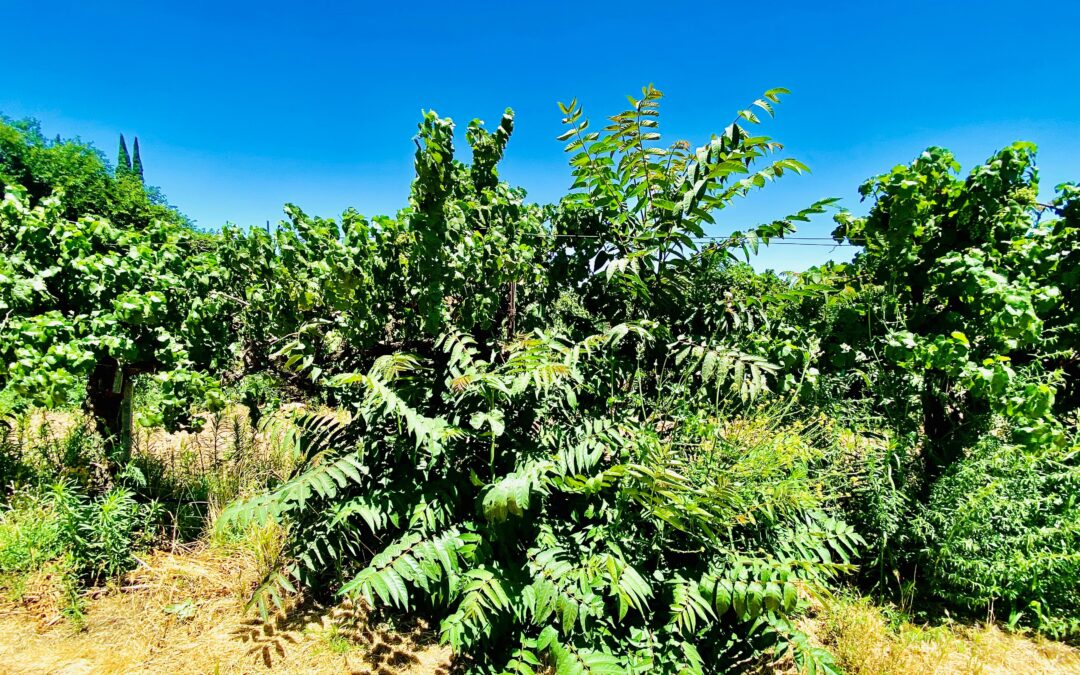WEDNESDAY, JULY 3, 2024. BY STEPHANIE BOLTON, PhD, GROWER RESEARCH & EDUCATION DIRECTOR, LODI WINEGRAPE COMMISSION.
Update on August 4, 2025: Help locate, inspect and kill the Tree of Heaven using the free iNaturalist app through a system set up by Maria Zumkeller. Click HERE.
Update on December 9, 2024: We need to be inspecting Trees of Heaven for spotted lanternfly egg masses year-round (see A in the photo below). Learn why and how HERE.
In case you haven’t heard, an invasive insect called the spotted lanternfly (Lycorma delicatula) is a huge problem on the east coast of the United States and is getting closer and closer to being our problem too. Originally from China, the spotted lanternfly poses such a major threat to grapevines and other crops that it is classified as a quarantine pest in our state of California. The spotted lanternfly was first discovered in the US in Pennsylvania in 2014.
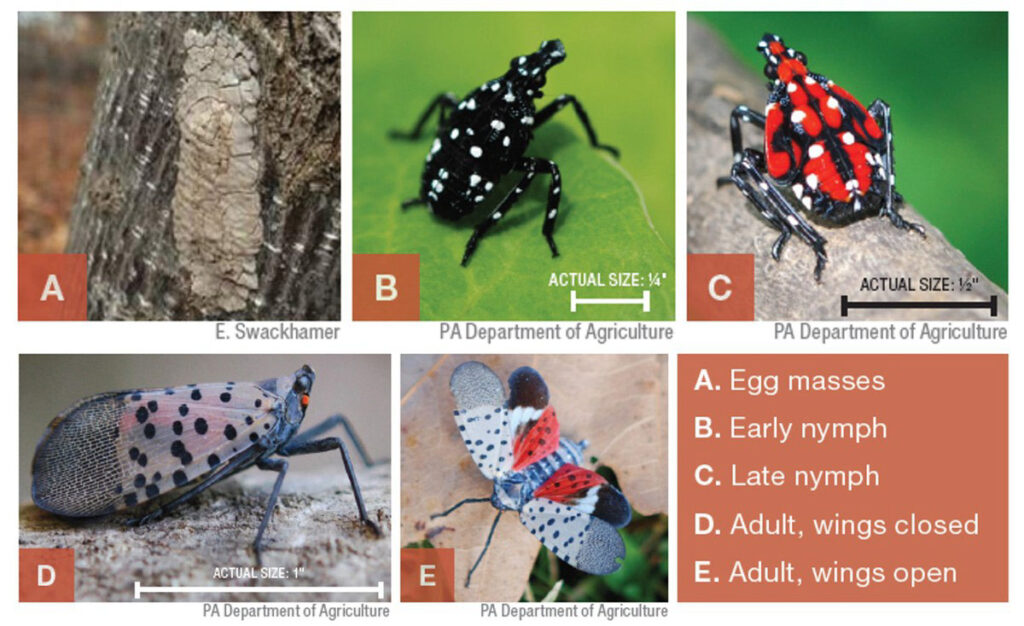
Spotted lanternfly life stages.
Californians are urged to learn how to identify the spotted lanternfly in its various forms and to report sightings immediately to the CDFA at 1-800-491-1899. Figure sourced from the Pennsylvania Department of Agriculture.
California Association of Winegrape Growers (CAWG) informed the wine industry that viable egg masses of the spotted lanternfly were found in our state on a 30-ft sculpture at the California Department of Food and Agriculture’s (CDFA) Truckee Ag Inspection Station in March. The art piece was traveling from New York to Sonoma. Inspectors intercepted 11 egg masses in Truckee and sent the sculpture back to Nevada, where a further inspection uncovered 30 more egg masses. The sculpture received a power wash and was allowed to pass through Truckee to Sonoma, where another inspection uncovered 3 additional egg masses. Read the full CAWG press release HERE.
With the recent find of viable egg masses, chances are now higher that the spotted lanternfly is already in California or is coming soon.
Over the past year, California outreach efforts have mainly focused on the spotted lanternfly quarantine, creating a statewide action plan and educating people on how to identify and report the spotted lanternfly. We believe it is time for the next step and we are actively taking that step in Lodi.
Thanks to our East Coast colleagues who are already battling the negative effects of the spotted lanternfly, we know that there is more we can do right now to protect our vineyards and California agriculture from the spotted lanternfly: We can immediately remove the insect’s preferred host plant, the Tree of Heaven, from our vineyard areas and our transportation pathways. The Tree of Heaven (pictured below) is an invasive noxious weed that is undesirable and extremely harmful to both ecosystems and infrastructures. It emits chemicals that are toxic to other plants and has been known to cause thousands of dollars worth of damage to underground pipes – one person shared online that this tree grew through her house and started coming out a light fixture in a bathroom.
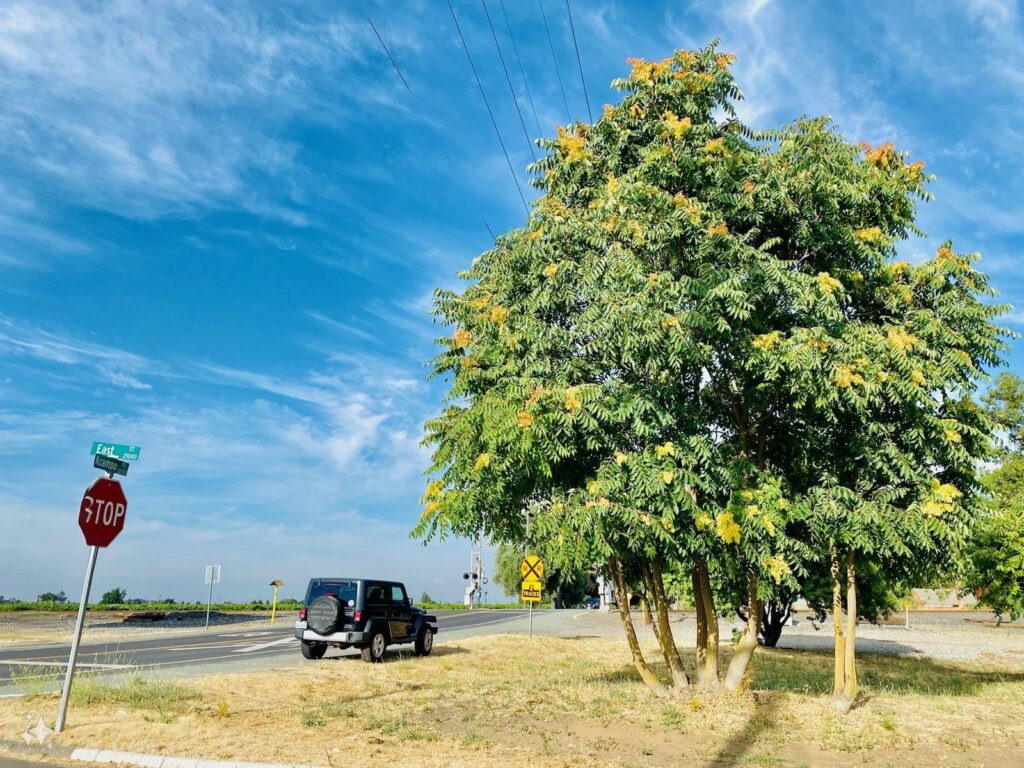
A large female Tree of Heaven with clumps of samaras (winged seeds) on public property next to railroad tracks and vineyards in Acampo, California.
Photo taken in June 2024 by Stephanie Bolton.
Several East Coasters have confirmed that removing the Tree of Heaven from ranches and transportation routes will help to protect California agriculture from the spotted lanternfly. When spotted lanternflies feed on the Tree of Heaven, they are less susceptible to predation from birds and other insects due to a protective bitter taste. Flor E. Acevedo, an Entomology Professor at Penn State, let us know that “Research with potted plants has demonstrated that when spotted lanternflies have access to Tree of Heaven they develop faster, have higher survival rates, and reproduce more.”
Kyle Beucke, California’s Primary State Entomologist with the CDFA, shared that spotted lanternfly adults have been observed jumping onto trains.
It’s a logical next step for our state to remove the spotted lanternfly’s preferred host, Tree of Heaven, from our railway and highway systems. Currently there is no statewide targeted action plan nor allocated funding to do so in California.
At the Lodi Winegrape Commission, we’re encouraging targeted removal of the Tree of Heaven on vineyard properties and transportation pathways this summer and we need everyone to get involved and help with this grassroots effort. Removal of a Tree of Heaven colony usually takes several years so we need to get started now. Solano County already has a funded vineyard-specific Tree of Heaven removal program through their County Agricultural Commissioner’s Office, utilizing a device called EZ-Ject plus foliar sprays.
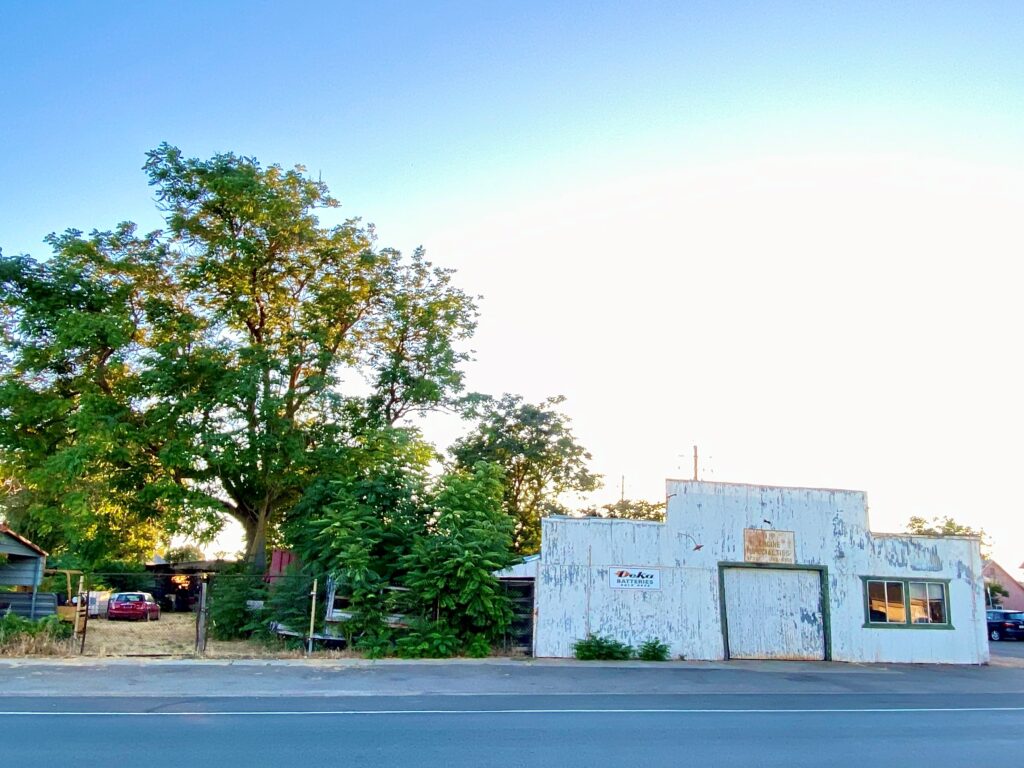
A huge Tree of Heaven with many offspring in Victor, CA. Ed King, Solano County Ag Commissioner, shared that “the more we’ve looked for Tree of Heaven, the more we’ve found.” This has been our experience as well.
Photo taken on July 1, 2024 by Stephanie Bolton.
We’re educating our broader winegrowing community, which for us includes growers, wineries, pest control advisors, consultants, conservation groups, city/county/state officials and citizens, on why we need to urgently remove the Tree of Heaven and how to properly remove it AFTER inspecting it for the spotted lanternfly. About 75 people gathered at the Lodi Winegrape Commission’s monthly Integrated Pest Management meeting on July 2 to learn more and left armed with the knowledge they need to join in the effort. We won’t be able to stop the spotted lanternfly from entering California, but at least there is something in our power that we can do right now to help protect our vineyards.
Since the Tree of Heaven is so adept at survival and proliferation, you cannot simply cut it down or dig it up or else the tree will vehemently start pushing up sprouts from its extensive underground root system. Even cutting a tree down then injecting herbicide into the stump, or cutting off branches, is not recommended. Please help us spread the word to roadside crews, power companies, growers, neighbors and people who maintain rental properties and public land.
Take a look at the before-vacation and after-vacation photos linked here which are kindly shared in a Reddit advice column from a southern California Tree of Heaven connoisseur who didn’t want her fate shared by others. She left for vacation for a month only to come home to hundreds of root sprouts after the neighbor chopped down 15-20 Trees of Heaven in their adjoining backyard.
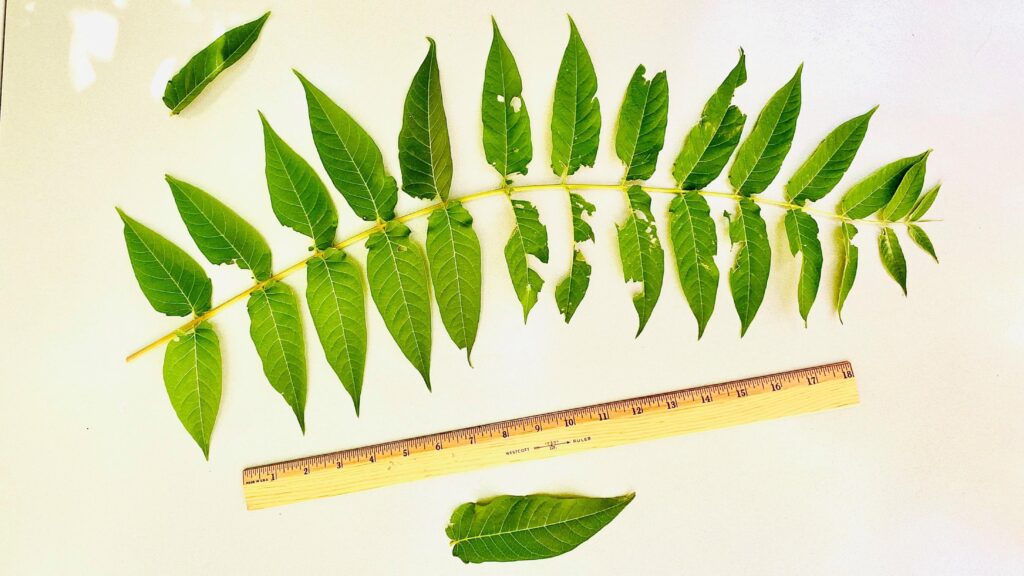
The Tree of Heaven (leaf and leaflets shown above) is easily confused with many other plants such as Black Walnut, Pecan, Sumac, Hickory, and Chinese Pistache. The Seek App by iNaturalist is free and easy to use for identification of this species. The leaf shape is also helpful for accurately identifying the tree, as the Tree of Heaven leaflets are smooth except for a few lobes with glands at the bottom (see blue arrows pointing to lobes and glands below). Crushed plant parts give off a nutty smell to some people. Photos by Stephanie Bolton.

In search of how to best remove the tree, we learned from nationwide extension publications, US Forest Service materials, YouTube videos, conversations with people who have experience with the tree, and public advice comments. Most advice recommends removing as much of the Tree of Heaven as possible, since it is a quick-growing and fast-multiplying nuisance in its own right. Some people suggest keeping one male tree around to trap and treat spotted lanternflies. Watch this free webinar shared with us by Brian Walsh, Spotted Lanternfly Researcher & Horticulture Educator from Penn State Extension, to learn more: extension.psu.edu/ailanthus-control-and-spotted-lanternfly-trap-tree-approaches. We also found the video linked below by Adam Downing, Virginia Cooperative Extension Forester, very helpful in learning how to remove the Tree of Heaven. (Beware of misinformation in California-based resources that say to dig it up, which is only effective for tiny plants which are growing from a seed in moist soil when you can pull out the entire root system.)
Time is of the essence, and the best time of the year to effectively remove the Tree of Heaven is July through before leaf drop, while the roots are at their weakest and while carbohydrates are traveling through the plant and down to the roots. The key is to kill the roots with targeted herbicide so that root suckers don’t continue to sprout and multiply. They can sprout from as far as 90 feet away from the main parent trunk.
Even tree lovers in Portland, Oregon claim that herbicides are justified for use with the ecosystem-destroying Tree of Heaven. Experts state that the most effective way to remove the Tree of Heaven is using an active ingredient called triclopyr, which is allowable on roadsides, abandoned lands, parking lots, train tracks and residential areas but not in California vineyards. Use caution when applying triclopyr as it can volatize and drift. Make sure that the temperature is below 85 degrees F, always consult your pest control advisor and read the label for information about protective gear and wind. Glyphosate carefully applied via the “hack and squirt” method is recommended for vineyard use on trees that are at least one inch in diameter or about the circumference of a quarter. With the “hack and squirt” application for this tree, the squirt needs to happen immediately (within 1-2 minutes) after the hack. KG Vineyard Management recommends using a tool called a “Red Weeder” or a very inexpensive adjustable dauber cement applicator device with a sponge head to ensure an extra level of safety when applying herbicide treatments to the Tree of Heaven.
Some growers have found it helpful to obtain a “right of ways” permit to best remove the Tree of Heaven from non-planted land. For more information on Tree of Heaven removal, the best resources we have found are the videos above and this Penn State Extension website: extension.psu.edu/tree-of-heaven.
Visit the Lodi Winegrape Commission office during normal business hours to get more information, including print copies of ID and management guides for the spotted lanternfly and the Tree of Heaven, plus resources for sharing this information with the rest of our community.
A special thanks to the many, many people/organizations who offered urgent advice, help and connections around this effort including the CDFA, Penn State, National Grape Research Alliance, CAWG, Virginia and UC Cooperative Extension, and the Solano County and San Joaquin County Agricultural Commissioner’s Offices.
To subscribe to the Coffee Shop Blog, send an email to stephanie@lodiwine.com with the subject “blog subscribe.”
To join the Lodi Growers email list, send an email to stephanie@lodiwine.com with the subject “grower email subscribe.”
To receive Lodi Grower news and event promotions by mail, send your contact information to stephanie@lodiwine.com or call 209.367.4727.

